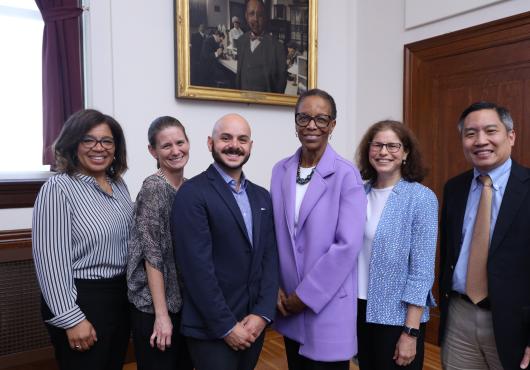Gender minority (transgender and gender nonbinary) Medicare beneficiaries had more mental health care, hospitalizations and emergency department visits than other Medicare beneficiaries from 2009-2014, according to a new study by Harvard Medical School and Cambridge Health Alliance researchers at the Health Equity Research Lab.
The study, published in the March issue of Health Affairs, is the first to describe these health care use outcomes for gender minority beneficiaries in Medicare. Lead author Ana Progovac, HMS instructor in psychiatry at Cambridge Health Alliance and a senior scientist at the Health Equity Research Lab, presented key findings during a Health Affairs press briefing in Washington, D.C., on March 6.
The study adds to a limited but growing research literature measuring health and health care needs for transgender and gender nonbinary people. Targeted surveys have shown that gender minority individuals face higher health and social burdens, including higher rates of homelessness and unemployment, physical and sexual abuse, and discrimination, as well as worse physical and mental health status. Gender minority people often report delaying needed medical care due to fear of discrimination.
An estimated one million people or more in the U.S. do not identify with their sex assigned at birth. They have been largely invisible in health care research because gender identity is rarely measured in nationally representative health survey and administrative datasets and in electronic health record systems. Gender identity is not currently measured in Medicare, either; the authors used a Centers for Medicare and Medicaid Services algorithm to identify beneficiaries likely to be gender minorities.
In this study, gender minority people were more likely to have mental health conditions and to be low income (eligible for Medicaid) than non-gender minority beneficiaries. Some of the largest differences in health care use were found for outpatient mental health visits and emergency department use. Adjusting for age and presence of mental health conditions, annual outpatient mental health visits were about 178 percent higher in gender minorities vs. non-gender minorities in the group over age 65, and 63 percent higher in the disabled beneficiary group. After adjusting for age and mental and physical comorbidities, annual emergency department use rates were about 35 percent higher for gender minorities in the group over 65 and 15 percent higher for the disabled group. Preventive care visits were mostly similar by gender identity.
“These findings point to a need for more research and policy efforts to improve the identification of gender identity across data sources,” said Progovac. “Strategies must be developed to improve health for gender minority individuals who have been largely ‘invisible’ in national health research.”
Other contributors to this article include Benjamin Lê Cook, Brian Mullin, Alex McDowell and Maria Jose Sanchez (from HMS and the Health Equity Research Lab at Cambridge Health Alliance), Ye Wang (Massachusetts General Hospital), Mark Schuster (Kaiser Permanente Medical School and formerly HMS and Boston Children’s Hospital) and Timothy Creedon, who was a member of the Health Equity Research Lab when this work was conducted.
This research was supported by the Centers for Medicare and Medicaid Services Office of Minority Health and its Health Equity Data Access Program, Harvard Catalyst | the Harvard Clinical and Translational Science Center, the National Institutes of Health (UL1TR001102, T32MH019733), the Patient-Centered Outcomes Research Institute, the Substance Abuse and Mental Health Services Administration, the Miller Innovation Fund, the Agency for Healthcare Research and Quality, and the Deborah Munroe Noonan Memorial Research Fund.
Adapted from a Cambridge Health Alliance news release.






